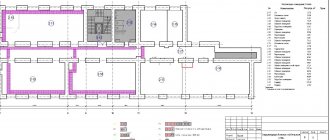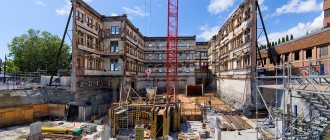Where to contact?
There is a certain sequence of actions:
- The first step (in the case when everything happens on a voluntary basis) is to draw up a special document - “Agreement on the division of non-residential premises.” This document describes in detail how the premises will be divided and the conditions of this process.
- Then you need to contact the BTI and call a technician, who, after inspecting the premises and taking measurements, will produce new technical plans and technical passports for each selected part.
- Order cadastral extracts from Rosreestr.
- Apply with a complete package of documents to the local branch of Rosreestr.
If there is no way to voluntarily divide the non-residential premises, or it is not possible to reach an agreement by mutual consent, then you will have to go to court in order to forcefully divide the real estate in the future. Then, on the basis of a court ruling, it will be possible to apply to the BTI.
Documentation
To complete the division procedure, the following documents will be required (provided for by Federal Law No. 218-FZ):
Articles on the topic (click to view)
- How is an agreement for the assignment of rights to an apartment under the DDU drawn up?
- What is more profitable: to continue living in a municipal apartment or to privatize it?
- The Supreme Court of the Russian Federation on the redevelopment and reconstruction of premises in an apartment building
- How does a mortgaged apartment become a property?
- Written consent of one of the spouses for the alienation, sale of the apartment and its sample
- What to do with a mortgaged apartment if a decision is made to divorce
- SAC RF: It is impossible to recognize a property as ownerless if the owner has not registered ownership of it
- An application to Rosreestr, which must contain a request to terminate the right of common shared ownership of this non-residential premises and to register individual ownership for each part (in accordance with technical passports). All owners sign the application.
- Agreement on division of premises.
- Title documents for this (original) object.
- Technical and cadastral documents for the original object.
- Extract from the Unified State Register of Real Estate.
- Technical documentation for new objects (parts of non-residential premises).
- Copies of passports (of all applicants).
- Receipts for payment of state duty (separate for each part).
- applications for termination of the right of common shared ownership of non-residential premises
- applications for termination of the right of common shared ownership of non-residential premises
How to divide a room or building into two separate parts?
Non-residential premises or a building can be divided into several parts if they are in shared ownership (Article 244 of the Civil Code of the Russian Federation). According to the legislation of the Russian Federation, such a division is possible if one of the following conditions is met:
- All owners of this property have provided voluntary consent to the division in writing and notarized.
- The division is carried out through the courts.
In addition to the Civil Code of the Russian Federation, the division of real estate is regulated by the Federal Law “On State Registration of Real Estate” dated July 13, 2015 No. 218-FZ.
What are the financial expenses?
The following expenses will be incurred:
- Payment of the state fee for registration of property rights is 2 or 22 thousand rubles, depending on whether the applicant is an individual or a legal entity.
- Payment of the state fee for registration of property rights is 2 thousand rubles (from an individual) or 22 thousand rubles (from a legal entity).
- Payment of the state duty for the production of a technical passport is 1200 rubles (if required urgently, then 2.5 thousand rubles).
What is given at the end of the procedure?
At the end of the procedure, the owners (each for their allocated part) receive:
- Separate cadastral numbers (how the number of non-residential premises is assigned during cadastral registration is written here).
- Extracts from the Unified State Register of Real Estate, which reflect information about the new premises that were formed as a result of the division and about the owner (certificates of ownership are not currently issued).
The division is considered completed once the rights of each owner are registered. Simultaneously with the cadastral registration of new objects, registration actions must also be carried out.
It is worth remembering that after dividing the premises into parts, the rights of shared ownership are retained (Article 250 of the Civil Code of the Russian Federation). Based on this, each co-owner has the right of first refusal in the event of the sale of one of the shares.
How to behave in case of refusal?
When conducting a legal examination, based on the documents provided, Rosreestr may decide to register and register ownership of the property of interest, and may also suspend or refuse to complete this procedure.
If the applicant is refused registration, the document must detail the reasons for this decision. It is necessary to contact a cadastral engineer, who must correct all the indicated shortcomings and errors and then independently send the corrected documents to the necessary authorities.
As a result, we can conclude that the division of non-residential real estate is certainly a long and difficult process. You need to be patient and comply with all legal requirements, take into account all the nuances.
It is best to try to agree with the remaining co-owners to make a division by mutual consent. If you go to court, the procedure may be delayed, and the financial costs will be higher.
Real estate transactions are individual, and therefore each of them has its own implementation scheme. Sometimes dividing the room into several parts can solve the problem. We will look at how to divide non-residential real estate into two parts in this article.
Various transactions with residential and non-residential real estate require a variety of legal support. Sometimes it is very difficult to manage shares in large premises. And in this case, the situation can be resolved exclusively through the official division of real estate into two parts.
Is it possible to divide property during a divorce?
Spouses have equal rights to common property. They can share it from the moment of purchase. The husband and wife determine the time and method independently.
The division of jointly acquired property can be carried out:
- During the period of official marriage.
- During the divorce process.
- After divorce.
The parties can settle a number of property issues before the wedding by concluding a prenuptial agreement. True, it will come into force only after the official registration of the marriage union.
The majority of spouses divide property, including real estate upon divorce.
Terms and costs of the section
In order to carry out construction work and legalize the division, you need to go through the stage of design, project approval, acceptance of work, and preparation of a technical plan. Only based on the results of these procedures can rights to newly created objects be registered. When determining the duration of each listed stage, the following requirements must be taken into account:
- the lead time for a redevelopment or reconstruction project depends on the complexity and volume of work, as well as on the qualifications and professionalism of the expert organization’s specialists (for example, contact, you can receive a redevelopment project within a few days);
- approval of redevelopment should not exceed 45 days, and correct execution of project documentation will allow you to complete this procedure the first time;
- a construction permit is issued by a supervisory authority, and the period for document verification can reach 2-3 months;
- after construction work has been completed and accepted, drawing up a technical plan will take from 1 day to several weeks (specialists will complete this work in 1-2 days, and in the most difficult situations no later than 5 days).
Expert opinion
Kuzmin Ivan Timofeevich
Legal consultant with 6 years of experience. Specializes in the field of civil law. Member of the Bar Association.
According to the rules of Federal Law No. 218-FZ, cadastral registration and registration activities are carried out within the framework of one procedure. It will take 10 days. If the documents are sent immediately to Rosreestr, or 12 days when applying through the MFC.
The cost of the work of designers and cadastral engineer is determined based on the volume and urgency of the order. To find out details of cooperation with, including prices for the design of the project and technical plan, call the numbers listed on the website.
Types of storage facilities and requirements for them
Places for storing goods and products are classified according to many criteria. For example, the following signs are taken into account:
- scale of activity;
- form of ownership of the organization;
- types of accommodation;
- conditions of safety;
- transport possibilities, proximity to access roads and railways;
- assortment range that can be taken for storage;
- logistics features of the company.
Most often, division is carried out according to the purpose of the territories. It is worth considering each group in more detail.
Industrial premises
They are located in areas used in the production of certain goods. There are direct work areas, as well as spaces used exclusively for warehousing, storage and loading and unloading. A conditional division into workshops and warehouses of finished products is used (it is worth listing the requirements for products in more detail, information is presented below).
This arrangement implies the appearance of industrial waste in different volumes, which must be disposed of or disposed of in another way. If this point is not provided for by contractual relations (deed of sale, lease, etc.), the owner is obliged to maintain all objects in proper condition and promptly remove generated waste from the territory.
"Cleverence" offers software for automating the management of storage facilities in order to optimize loading, unloading, packaging, disposal and use other effective solutions to improve business processes (for example, "Warehouse 15").
Transshipment facilities
Used for cargo transit. All objects are kept in such territories for a short time. For example, this is required during transportation. As a rule, they are located near ports, railways, and large transport hubs.
Reserve warehouses
Indicated for use in case of emergency situations at work or a certain area of the area. Equipped with strategic reserves and mobilization equipment. This also includes a narrower category of military warehouses created specifically to meet the needs of the Russian army.
Warehouses
These are premises that provide short-term storage of goods on the railway, in ports, and customs. The design is created with the condition that, if necessary, loading and unloading is carried out very quickly. Often such closed premises were used to preserve valuable goods and objects subject to rapid deterioration under the influence of atmospheric phenomena.
For seasonal storage
Mainly used in agricultural activities and agro-industrial complexes. Vegetables and other seasonal products are stored here.
Warehouses for subsequent sale wholesale and retail
These are warehouse spaces in which products transferred from manufacturers for sale in retail chains are stored. Here, not only goods are received and sorted, but also they are prepared for shipment to stores.
Another location option has become widespread, when warehouses are located on the same territory as offices. A distinctive feature is its territorial location directly in the city, which is a huge plus for both the owner and those renting useful space. Thanks to this, the costs of transport services, zone maintenance, and waiting time for customers and other interested parties are significantly reduced.
Allocation of premises for registration of a lease agreement
If the entire building or premises is leased, an agreement signed by both parties is submitted for registration. However, Federal Law No. 218-FZ allows the transfer of part of the premises to the tenant, and for this it is not necessary to draw up an allocation confirming the signs of isolation and isolation.
Here are the rules that may apply to the temporary allocation of premises for registration of lease:
- a temporary facility may not have structures enclosing its area at all, or may have symbols (markers on the floor, tape, sales counters around the perimeter, etc.);
- the parties must indicate all the characteristics of such an object in the contract, including its location within the common premises, area, etc.;
- on the basis of the contract, the cadastral engineer will conduct a survey and indicate the location of the temporary facility on the premises diagram or floor plan - this information will be entered into the technical plan, and then in the Unified State Register of Real Estate.
Based on the technical plan, the allocated part of the premises will be placed on temporary cadastral registration - this procedure will take place simultaneously with the registration of the lease agreement.
Allocation of part of the premises for rental purposes is the optimal form of transferring large retail space to small organizations or entrepreneurs. The advantage of this form of lease is the ease of determining the boundaries - the parties can agree on them without erecting any fences.
A cadastral engineer will prepare a technical plan within a few days, which will allow you to complete the entire registration procedure as quickly as possible.
Division of a building is a legal procedure for distributing rooms of a building into new legal objects in compliance with the requirements of isolation and separation of Federal Law No. 218.
The ability to carry out a division is provided for by law only for homogeneous real estate objects. Consequently, the building can only be divided into several rooms.
The premises are an independent object of cadastral registration, therefore, they can be formed within the boundaries of the building, or separated from another premises, while it is necessary to take into account the rules established by Federal Law No. 218 “On State Registration of Real Estate”.
Conditions of separation
There are two main requirements that the shared premises must meet - isolation and isolation of the property:
- Isolation exists when there are four walls (with or without windows) and a separate entrance. Walls cannot be replaced with temporary partitions: they must be permanent and permanent. And there should be only one entrance. If there are two or more entrances, then the property is no longer considered isolated.
- Isolation - the presence of a separate entrance to public places: to the entrance of a house, to the street, etc.
If these requirements are not met, the room cannot be divided. In certain situations, you will have to carry out redevelopment: remove or add additional exits, install walls, etc.
It is desirable that the base room can be used for its intended purpose. Example: the premises are considered a warehouse, but due to unauthorized redevelopment, they cannot be used for storing certain products. In such a situation, the Unified State Register of Real Estate has the right not to issue permission for division.
The created real estate objects must also meet a number of requirements:
- Natural light sources are available - that is, there are windows. They must provide sufficient lighting during daylight hours.
- Electricity and heating are provided, there is access to water and sewerage.
- The room meets the minimum area requirements - at least 12 square meters.








